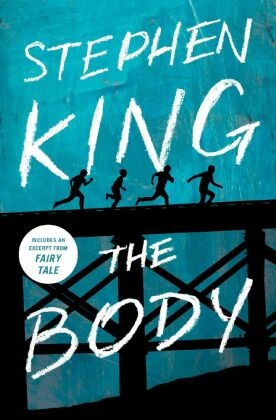| Verlag | Simon & Schuster US |
| Auflage | 2018 |
| Seiten | 192 |
| Format | 13,9 x 21,2 x 1,2 cm |
| Trade Paperback | |
| Gewicht | 188 g |
| Artikeltyp | Englisches Buch |
| ISBN-10 | 1982103531 |
| EAN | 9781982103538 |
| Bestell-Nr | 98210353UA |
Set in the fictional town of Castle Rock, Maine
#1 New York Times bestselling author Stephen King's timeless novella "The Body"-originally published in his 1982 short story collection Different Seasons, and adapted into the 1986 film classic Stand by Me-is now available as a stand-alone publication.
It's 1960 in the fictional town of Castle Rock, Maine. Ray Brower, a boy from a nearby town, has disappeared, and twelve-year-old Gordie Lachance and his three friends set out on a quest to find his body along the railroad tracks. During the course of their journey, Gordie, Chris Chambers, Teddy Duchamp, and Vern Tessio come to terms with death and the harsh truths of growing up in a small factory town that doesn't offer much in the way of a future.
A timeless exploration of the loneliness and isolation of young adulthood, Stephen King's The Body is an iconic, unforgettable, coming-of-age story.
Leseprobe:
The Body 11
We got to the dump around one-thirty, and Vern led the way down the embankment with a Paratroops over the side! We went to the bottom in big jumps and leaped over the brackish trickle of water oozing listlessly out of the culvert which poked out of the cinders. Beyond this small boggy area was the sandy, trash-littered verge of the dump.
There was a six-foot security fence surrounding it. Every twenty feet weather-faded signs were posted. They said:
CASTLE ROCK DUMP
HOURS 4-8 P.M.
CLOSED MONDAYS
TRESPASSING STRICTLY FORBIDDEN
We climbed to the top of the fence, swung over, and jumped down. Teddy and Vern led the way toward the well, which you tapped with an old-fashioned pump-the kind from which you had to call the water with elbow-grease. There was a Crisco can filled with water next to the pump handle, and the great sin was to forget to leave it filled for the next guy to come along. The iron handle stuck off at a n angle, looking a one-winged bird that was trying to fly. It had once been green, but almost all of the paint had been rubbed off by the thousands of hands that had worked that handle since 1940.
The dump is one of my strongest memories of Castle Rock. It always reminds me of the surrealist painters when I think of it-those fellows who were always painting pictures of clockfaces lying limply in the crotches of trees or Victorian living rooms standing in the middle of the Sahara or steam engines coming out of fireplaces. To my child's eye, nothing in the Castle Rock Dump looked as if it really belonged there.
We had entered from the back. If you came from the front, a wide dirt road came in through the gate, broadened out into a semicircular area that had been bulldozed as flat as a dirt landing-strip, and then ended abruptly at the edge of the dumping-pit. The pump (Teddy and Vern were currently standing there and squabbling about who was going to prime it) was at the back of this great pit. It was maybe eighty feet deep and filled with all the American things that get empty, wear out, or just don't work anymore. There was so much stuff that my eyes hurt just looking at it-or maybe it was your brain that actually hurt, because it could never quite decide what your eye should stop on. Then your eye would stop, or be stopped, by something that seemed as out of place as those limp clockfaces or the living room in the desert. A brass bedstead leaning drunkenly in the sun. A little girl's dolly looking amazedly between her thighs as she gave birth to stuffing. An overturned Studebaker automobile with its chrome bullet nose glittering in the sun like some Buck Rogers missile. One of those giant water bottles they have in office buildings, transformed by the summer sun into a hot, blazing sapphire.
There was plenty of wildlife there, too, although it wasn't the kind you see in the Walt Disney nature films or at those tame zoos where you c an pet the animals. Plump rats, wood-chucks grown sleek and lumbering on such rich chow as rotting hamburger and maggoty vegetables, seagulls by the thousands, and stalking among the gulls like thoughtful, introspective ministers, an occasional huge crow. It was also the place where the town's stray dogs came for a meal when they couldn't find any trashcans to knock over or any deer to run. They were a miserable, ugly-tempered, mongrel lot; slat-sided and grinning bitterly, they would attack each other over a flyblown piece of bologna or a pile of chicken guts fuming in the sun.
But these dogs never attacked Milo Pressman, the dump-keeper, because Milo was never without Chopper at his heel. Chopper was-at least until Joe Camber's dog Cujo went rabid twenty years later-the most feared and least seen dog

